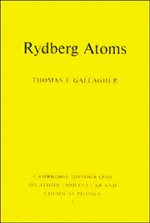Book contents
- Frontmatter
- Contents
- Preface
- 1 Introduction
- 2 Rydberg atom wavefunctions
- 3 Production of Rydberg atoms
- 4 Oscillator strengths and lifetimes
- 5 Black body radiation
- 6 Electric fields
- 7 Pulsed field ionization
- 8 Photoexcitation in electric fields
- 9 Magnetic fields
- 10 Microwave excitation and ionization
- 11 Collisions with neutral atoms and molecules
- 12 Spectral line shifts and broadenings
- 13 Charged particle collisions
- 14 Resonant Rydberg–Rydberg collisions
- 15 Radiative collisions
- 16 Spectroscopy of alkali Rydberg states
- 17 Rf spectroscopy of alkaline earth atoms
- 18 Bound He Rydberg states
- 19 Autoionizing Rydberg states
- 20 Quantum defect theory
- 21 Optical spectra of autoionizing Rydberg states
- 22 Interseries interaction in bound states
- 23 Double Rydberg states
- Index
5 - Black body radiation
Published online by Cambridge University Press: 29 September 2009
- Frontmatter
- Contents
- Preface
- 1 Introduction
- 2 Rydberg atom wavefunctions
- 3 Production of Rydberg atoms
- 4 Oscillator strengths and lifetimes
- 5 Black body radiation
- 6 Electric fields
- 7 Pulsed field ionization
- 8 Photoexcitation in electric fields
- 9 Magnetic fields
- 10 Microwave excitation and ionization
- 11 Collisions with neutral atoms and molecules
- 12 Spectral line shifts and broadenings
- 13 Charged particle collisions
- 14 Resonant Rydberg–Rydberg collisions
- 15 Radiative collisions
- 16 Spectroscopy of alkali Rydberg states
- 17 Rf spectroscopy of alkaline earth atoms
- 18 Bound He Rydberg states
- 19 Autoionizing Rydberg states
- 20 Quantum defect theory
- 21 Optical spectra of autoionizing Rydberg states
- 22 Interseries interaction in bound states
- 23 Double Rydberg states
- Index
Summary
Lying ≥4 eV above the ground state, Rydberg states are not populated thermally, except at very high temperatures. Accordingly, it is natural to assume that thermal effects are negligible in dealing with Rydberg atoms. However, Rydberg atoms are strongly affected by black body radiation, even at room temperature. The dramatic effect of thermal radiation is due to two facts. First, the energy spacings ΔW between Rydberg levels are small, so that ΔW < kT at 300 K. Second, the dipole matrix elements of transitions between Rydberg states are large, providing excellent coupling of the atoms to the thermal radiation. The result of the strong coupling between Rydberg atoms and the thermal radiation is that population initially put into one state, by laser excitation for example, rapidly diffuses to other energetically nearby states by black body radiation induced dipole transitions. Both the redistribution of population and the implicit increase in the radiative decay rates are readily observed. Although the above mentioned effects on level populations are the most obvious effects, the fact that a Rydberg atom is immersed in the thermal radiation field increases its energy by a small amount, 2 kHz at 300 K. While the radiation intensity is vastly different in the two cases, this effect is the same as the ponderomotive shift of the ionization limit in high intensity laser experiments.
- Type
- Chapter
- Information
- Rydberg Atoms , pp. 50 - 69Publisher: Cambridge University PressPrint publication year: 1994

